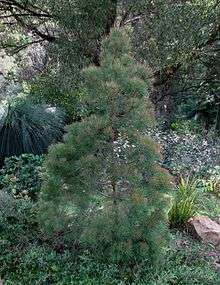Gymnostoma australianum
Gymnostoma australianum, also named the Daintree pine or oak, is a species of small trees which are (endemic) to a restricted area of the Daintree tropical rainforests region, of the larger region of the Wet Tropics of north-eastern Queensland, Australia.[1][3][4][5] They constitute part of the plant family Casuarinaceae, often named she-oaks, members of which are characterised by drooping equisetoid (meaning "to look like Equisetum") evergreen foliage, and separate male and female flowers (unisexual).[1] Superficially they look like well known scale–leaved gymnosperm trees species, such as Cupressus in the northern hemisphere and Callitris in the southern hemisphere.
| Gymnostoma australianum | |
|---|---|
.jpg) | |
| Foliage, fruits and flowers, May 2014, in cultivation, Mount Coot-tha Botanic gardens, Brisbane | |
 | |
| Young tree, April 2014, in cultivation, Australian National Botanic Gardens, Canberra | |
| Scientific classification | |
| Kingdom: | Plantae |
| Clade: | Tracheophytes |
| Clade: | Angiosperms |
| Clade: | Eudicots |
| Clade: | Rosids |
| Order: | Fagales |
| Family: | Casuarinaceae |
| Genus: | Gymnostoma |
| Species: | G. australianum |
| Binomial name | |
| Gymnostoma australianum | |
Within their restricted distribution in the Daintree rainforests region, they usually grow in the habitats of open, sunny, long-term rainforest gaps, ranging, from the lowlands to the uplands, in regularly flooded river bank (riparian) situations through to rocky or exposed, wet, cloudy, mountain top situations, including recorded collections from 0 to 1,350 m (0 to 4,429 ft) altitude.[1][3][4][5]
Their roots have nitrogen-fixing nodules.[1] They grow into small trees of 4–7 m (13–23 ft) tall. Mature trees bear cone–structure fruits 7–15 mm (0.3–0.6 in) long X 8–15 mm (0.3–0.6 in) wide. When ripe each cone's numerous valves open to release the dark–coloured winged seeds 7–8 mm long.[1][4][5]
They have obtained the Queensland government's official conservation status of "vulnerable" species.[6]
References
- Johnson, Lawrie A. S. (1989). "Gymnostoma australianum L.A.S.Johnson". In George, Alex S. (ed.). Flora of Australia: Volume 3: Hamamelidales to Casuarinales. Flora of Australia series. Collingwood, Victoria: CSIRO Publishing / Australian Biological Resources Study. pp. 103, 202, figs 45, 46, map 105. ISBN 978-0-644-08499-4. Retrieved 5 Dec 2013.
- "Gymnostoma australianum". Australian Plant Name Index (APNI), Integrated Botanical Information System (IBIS) database (listing by % wildcard matching of all taxa relevant to Australia). Centre for Plant Biodiversity Research, Australian Government. Retrieved 5 Dec 2013.
- Hyland, B. P. M.; Whiffin, T.; Zich, F. A.; et al. (Dec 2010). "Factsheet – Gymnostoma australianum". Australian Tropical Rainforest Plants (6.1, online version RFK 6.1 ed.). Cairns, Australia: Commonwealth Scientific and Industrial Research Organisation (CSIRO), through its Division of Plant Industry; the Centre for Australian National Biodiversity Research; the Australian Tropical Herbarium, James Cook University. Retrieved 5 Dec 2013.
- Prider, Jane N.; Christophel, David C. (2000). "Distributional ecology of Gymnostoma australianum (Casuarinaceae), a putative palaeoendemic of Australian wet tropic forests". Australian Journal of Botany. 48 (4): 427–434. doi:10.1071/BT99006.
- Cooper, Wendy; Cooper, William T. (June 2004). "Gymnostoma australianum L.A.S.Johnson". Fruits of the Australian Tropical Rainforest. Clifton Hill, Victoria, Australia: Nokomis Editions. p. 561. ISBN 9780958174213. Archived from the original on 9 April 2013. Retrieved 5 Dec 2013.
- Queensland Government (27 Sep 2013). "Nature Conservation (Wildlife) Regulation 2006" (PDF). Nature Conservation Act 1992. Online, accessed from www.legislation.qld.gov.au. Australia. p. 51. Retrieved 5 Dec 2013.